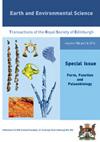矿物组成氧同位素与外部渗透流体部分再平衡的化石热液系统理论反演
IF 0.9
4区 地球科学
Q4 GEOSCIENCES, MULTIDISCIPLINARY
Earth and Environmental Science Transactions of the Royal Society of Edinburgh
Pub Date : 2021-06-01
DOI:10.1017/S1755691021000244
引用次数: 2
摘要
虽然通过稳定同位素已经确定了现代地热和/或化石热液系统中水的外部入渗,但常规正演模拟隐含地假设或经验地估计了水的初始氧同位素$({{\rm \delta}^{18}{\rm O}_{\rm W}}^{\rm i}}) $和岩石的物理化学边界条件以及蚀变温度。本文提出了一种处理组成矿物与水之间氧同位素部分再平衡的新方法,从理论上反演了中国中东部大别造山带早白垩世碰撞后花岗岩和侵入的三叠纪片麻质围岩的外渗大气水和岩浆水。$ {{\rm \delta}^{18}{\rm O}_{\rm W}^{\rm i}} $值为- 11.01‰的大气水由花岗岩类向外渗透,并在140℃时与造岩矿物进行热力学再平衡,水/岩(W/R) O比最小为1.10左右,为开放体系。该大气热液系统的寿命动力学约束小于70万年(Myr),通过模拟表面反应氧交换。在340°C时,岩浆水$ {{\rm \delta}^{18}{\rm O}_{\rm W}}}{\rm i}} $值为4.21‰,(W/R) O比值为1.23,岩浆热液系统持续时间不超过1.2万年(Kyr),与造岩矿物迅速重新平衡。然而,从理论上讲,水的外部入渗可以用再平衡造岩矿物的氧同位素进行反演,并且可以可靠地量化世界范围内大陆造山带内岩浆作用或变质作用驱动的古代热液系统。本文章由计算机程序翻译,如有差异,请以英文原文为准。
Theoretical inversion of the fossil hydrothermal systems with oxygen isotopes of constituent minerals partially re-equilibrated with externally infiltrated fluids
ABSTRACT While the external infiltration of water has been identified from modern geothermal and/or fossil hydrothermal systems through stable isotopes, the physicochemical boundary conditions like the initial oxygen isotopes of water $( {{\rm \delta }^{ 18}{\rm O}_{\rm W}^{\rm i} } ) $ and rock as well as alteration temperature were implicitly presumed or empirically estimated by the conventional forward modelling. In terms of a novel procedure proposed to deal with partial re-equilibration of oxygen isotopes between constituent minerals and water, the externally infiltrated meteoric and magmatic water are theoretically inverted from the early Cretaceous post-collisional granitoid and intruded Triassic gneissic country rock across the Dabie orogen in central-eastern China. The meteoric water with a $ {{\rm \delta }^{ 18}{\rm O}_{\rm W}^{\rm i} } $ value of −11.01 ‰ was externally infiltrated with a granitoid and thermodynamically re-equilibrated with rock-forming minerals at 140°C with a minimum water/rock (W/R)o ratio around 1.10 for an open system. The lifetime of this meteoric hydrothermal system is kinetically constrained less than 0.7 million years (Myr) via modelling of surface reaction oxygen exchange. A gneissic country rock, however, was externally infiltrated by a magmatic water with $ {{\rm \delta }^{ 18}{\rm O}_{\rm W}^{\rm i} } $ value of 4.21 ‰ at 340°C with a (W/R)o ratio of 1.23, and this magmatic hydrothermal system could last no more than 12 thousand years (Kyr) to rapidly re-equilibrate with rock-forming minerals. Nevertheless, the external infiltration of water can be theoretically inverted with oxygen isotopes of re-equilibrated rock-forming minerals, and the ancient hydrothermal systems driven by magmatism or metamorphism within continental orogens worldwide can be reliably quantified.
求助全文
通过发布文献求助,成功后即可免费获取论文全文。
去求助
来源期刊
CiteScore
2.00
自引率
0.00%
发文量
21
期刊介绍:
Earth and Environmental Science Transactions (formerly Transactions of the Royal Society of Edinburgh: Earth Sciences) is a general earth sciences journal publishing a comprehensive selection of substantial peer-reviewed research papers, reviews and short communications of international standard across the broad spectrum of the Earth and its surface environments. The journal prides itself on the quality of its graphics and photographic reproduction. The Editors are keen to encourage interdisciplinary papers and Transactions also publishes occasional special symposia and invited volumes of specific interest.
We are currently in the process of digitising the archive of RSE Publications, and the archive of the Transactions, dating back to 1788, will be available from the back issues link on this site.

 求助内容:
求助内容: 应助结果提醒方式:
应助结果提醒方式:


